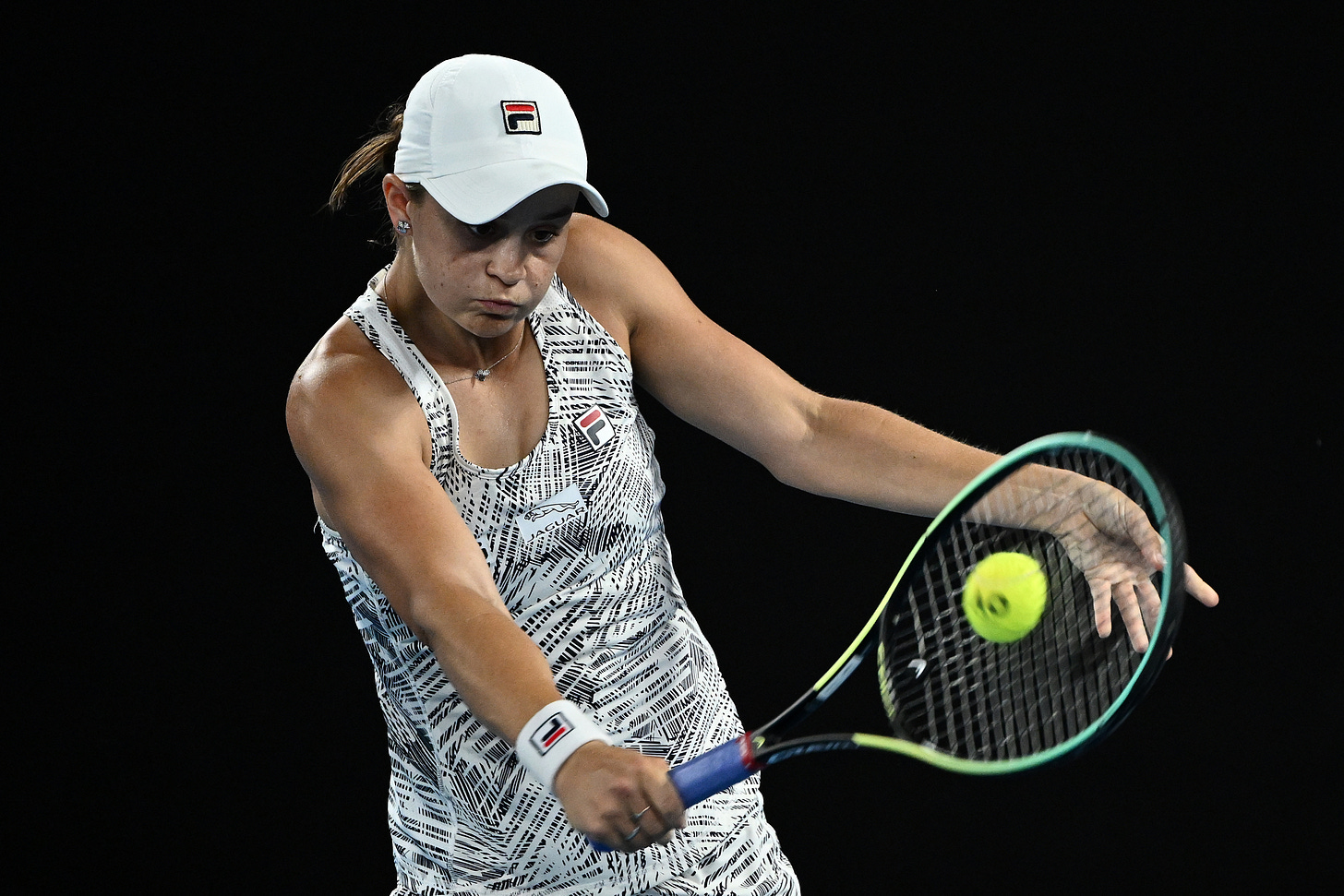After Ash Barty, on her way to winning the Australian Open, beat Madison Keys in the semi finals last week, her coach Craig Tyzzer said this:

I thought this was one of the more interesting recent coach quotes. It’s also completely accurate. Barty’s slice has terrorised much of the tour over the last few years and is a not-insignificant part of why she’s world No.1 and winner of two out of the three last Slams played. That slice, and especially how good it is, is a relatively rare sight at the very top of the women’s game right now. But how rare is it?
Madison Keys played some wonderful tennis to make it to the semi-finals, before getting completely dismantled by Barty 6-1, 6-3. I took a look at how many slices Keys had to face in her first five rounds, and then how many she had to face against Barty:
(Backhand and forehand slices, but vast majority are backhands)
You are not reading that wrong. 36% of the total points played in the Barty vs Keys match featured Keys facing at least one slice, compared to mostly single digits, or at most 13%, in previous rounds. As for total slices faced, Barty made Keys face a slice 12.5x more often than Krejčíková, 10x more often than Wang, 6.8x more often than Badosa, 7.2x more often than Cristian, and 3.3x more often than Kenin. For most of those opponents it’s almost like playing a different sport when Key’s has to play Barty.
You also have to factor in the fact that Barty’s slice is just straight up better than almost everyone else’s on tour right now, and her two handed backhand worse, which means her slices are less likely to be merely desperate, defensive shots (as they were for the vast majority of Kenin’s, Cristian’s, Wang’s, Badosa’s, and Krejčíková’s counted shots) and instead are often also neutral rally or forcing shots.
Hilariously, the Barty Keys matchup doesn’t even produce as many slices from Barty as many other matchups featuring the World No.1. And yet the gulf is still enormous. 85% of the times when Keys had to face a Barty slice were in Key’s own service games, which is unsurprising considering Barty likes to use her slice block return (and follow up slice if pushed to the backhand) to neutralise serving advantage before setting up her own forehand.

Madison Key’s avg through the first five rounds:
1st Serve Points Won: 73%
Unreturned 1st Serves: 44%
Against Barty:
1st Serve Points Won 49%
Unreturned 1st Serves: 21%
If Barty was able to neutralise Key’s first strike or two of the point, she could happily construct points to set up her forehand weapon as below:
Of course Barty also happens to have one of the most effective and accurately placed serves on tour right now, which, along with her slice return/rally neutralisers, forehand weapon, and speedy lateral movement, combine to create an extremely complete player, especially against the backdrop of the current WTA environment.
ENOUGH SLICES
A lot is made of how much of a differentiator Barty’s slice is right now at the top of the game, and rightly so. But it’s really interesting to quantify just how unusual it is for many of the top players who currently have the misfortune in facing her. It’s almost like two different sports at the moment. The first one, competing against Top 10 players, many of whom employ a linear power, baseline game. And the second one having to not only deal with a great serve and forehand, but also playing Barty out on her own specialty island of rally and return slices.
Many of her opponents are probably internally screaming this to themselves for large portions of their matches:
Enough slices indeed, but not for the world No.1.
— MW
Twitter: @mattracquet
I’ll see paid subscribers on Sunday.
The Racquet goes out twice a week, a (free) piece every Thursday and a (paid) analysis piece every Sunday/Monday. You can subscribe here:
Top: Quinn Rooney/Getty, Bottom: Clive Brunskill/Getty
Most recent:









Interesting analysis. Thank you. It was fascinating to watch Raducanu vs Kovinic in the second round of the AO. In the second set, Raducanu completely dominated Kovinic, who had no answer to Raducanu's sliced forehand. Radders was unable to use her favourite topspin forehand due to blisters, after coming back from a Covid-induced layoff, so resorted to a forehand slice. Obviously this didn't put pressure on a tender spot, because she uses the slice so infrequently in practice!
As the match went on, the medic tried a new bandage, which gave some protection to the topspin forehand, and Radders returned to using it. This was a mistake, in my opinion. If she had persevered with the slice, saving the forehand for occasional winners, she might well have won that match, as Kovinic was bamboozled by it. We know Radders is good at learning on the run. But this time, she simply couldn't let go of her familiar topspin forehand.
I would love to see her develop the slice as a weapon. But I don't think coach Beltz is bold enough to experiment with it this early in her career. It would actually be the perfect time to learn this shot, if her profile wasn't so high.
How come the slice is so underused at pro level? Can't even think of many players that can really punish you for it (outside Nadal, I don't understand how he does it, if I try to attack a slice in that manner I usually brush it too vertically and end up framing it).